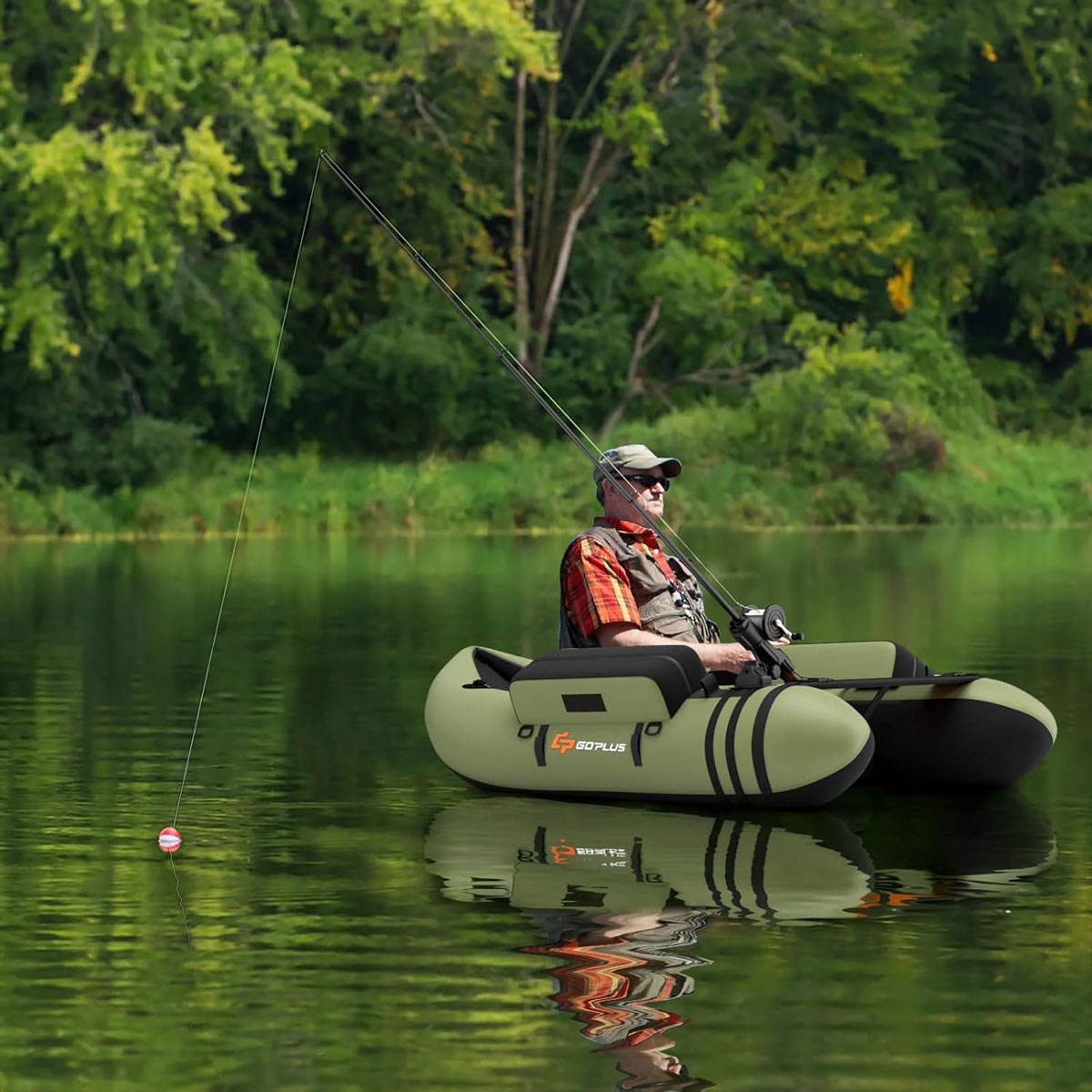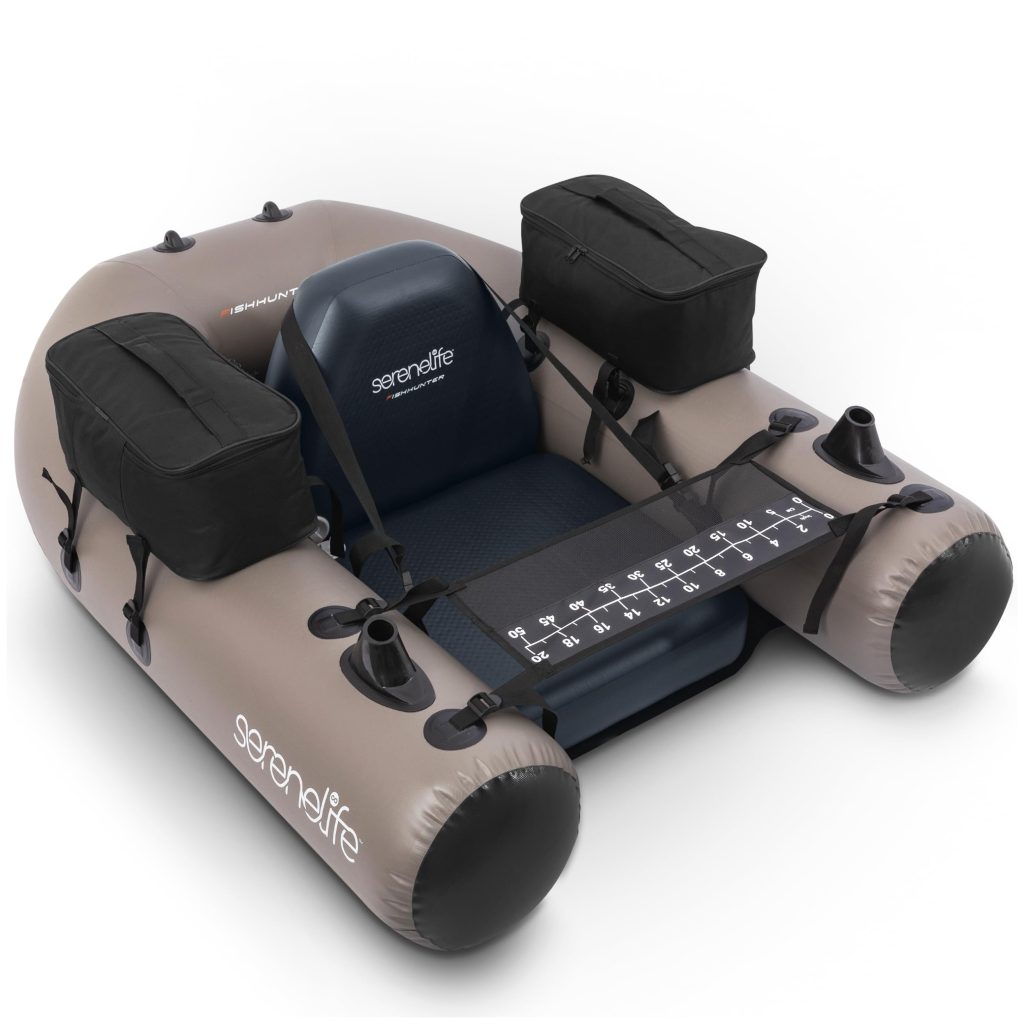Fishing from a float tube boat opens up a whole new world—deeper water, bigger fish, and honestly, just a different vibe than you get from the bank. Float tube boats are purpose-built for drifting naturally with the current, letting you present your bait right where you want it. They’re stable, pretty nimble, and just really well-suited for this style of fishing.
Most float fishing boats have a flat or slightly modified hull, which keeps things steady and lets you drift without much fuss. You’ll usually find rod holders, live wells, and storage spots for all your float fishing gear. Thanks to their shallow draft, these boats can sneak into rivers, lakes, and even some coastal spots that deeper boats just can’t handle.
Picking out a float fishing boat? Hull shape and what it’s made of are probably the first things you’ll want to check. Make sure the size and weight rating fit your crew and how much stuff you bring along. Storage, seat comfort, and whether you can throw a motor on it all matter, too. We spent a lot of time testing and researching to find float fishing boats that hit the sweet spot for stability, features, and bang for your buck—they’re aimed at folks who take their fishing seriously.
Our Best Float Fishing Boats
Here’s our full list of top float fishing boats. We tried each one out, focusing on stability, comfort, and fishing-friendly features to help you narrow it down.
Intex Big Catch Pro Float Tube
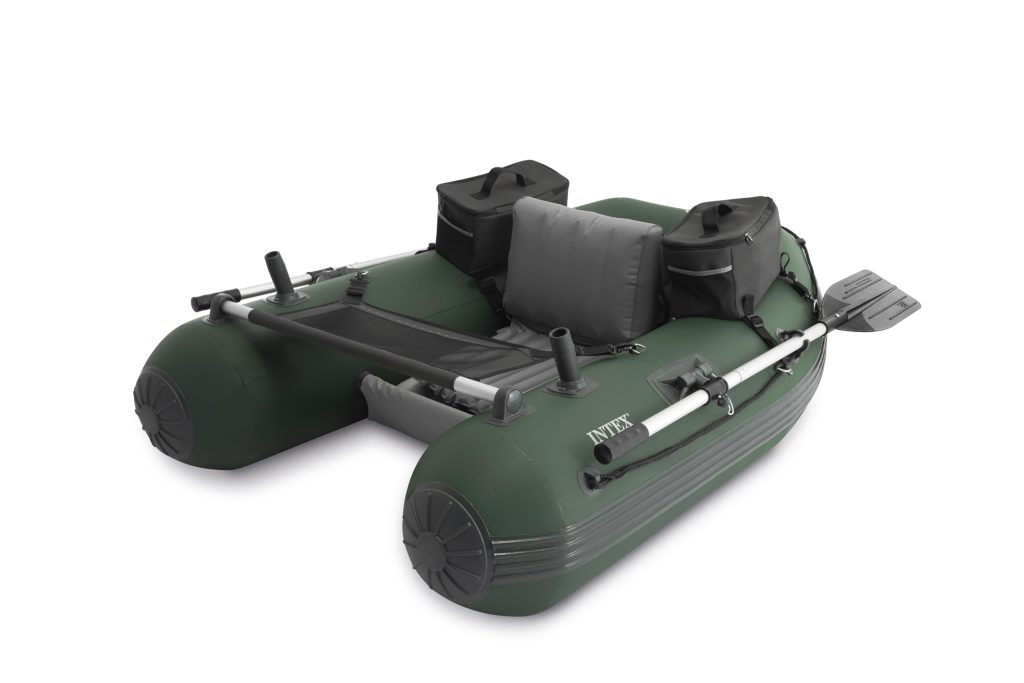
The Big Catch Pro is super stable and feels tough enough for serious anglers, but it’s not exactly lightweight if you’re hiking in solo.
Pros
- Feels rock-solid, even if you’re on the heavier side or carrying a lot of gear
- Three-layer construction—seems like it’ll hold up for ages
- Comes with oars, a pump, and a backpack that’s actually decent
Cons
- At 30 pounds, it’s a beast to carry by yourself
- Rod holders aren’t perfect—some rods just don’t sit right
- Even deflated, it takes up a chunk of storage space
We put in some serious hours testing this tube on lakes and rivers. Right away, the stability stood out—no sketchy moments, even when moving around or casting in awkward spots. The thick material inspires confidence; you’re not constantly worried about scraping something sharp.
Setup is about 15 minutes with the included pump. Valves work smoothly, and once it’s full, the floor stays firm. The backpack does its job, but you’ll feel those 30 pounds on a long walk. Oars stow away easily, and the skeg actually helps in wind.
Pockets are handy for tackle and random gear, and the mesh ruler is a neat touch. After a bunch of outings, we think it’s a solid buy for the money.
Goplus Inflatable Float Tube
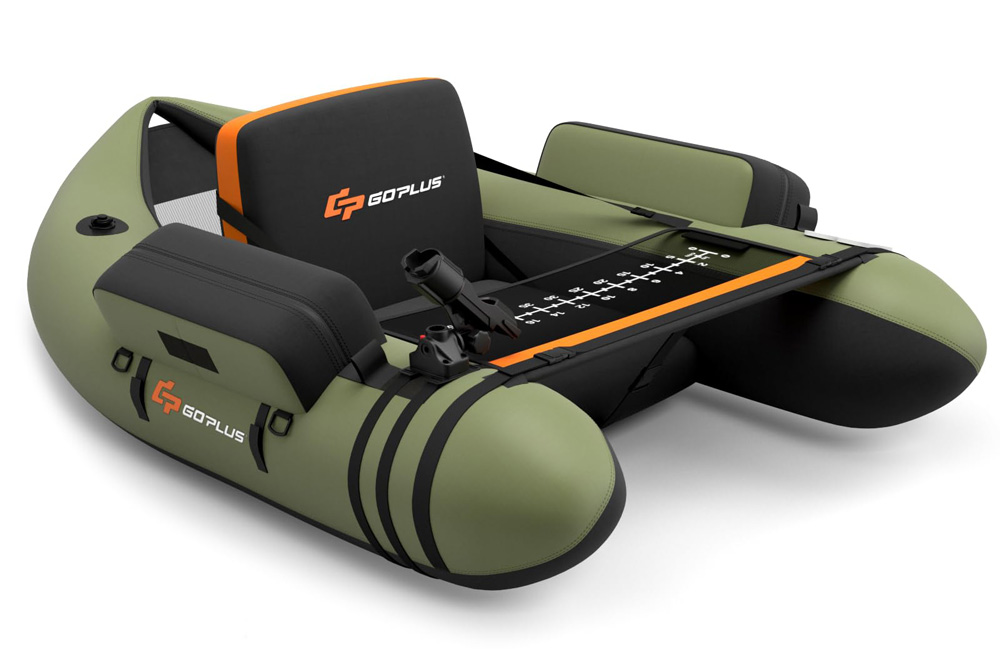
If you’re watching your budget but still want something that works, this float tube gets the job done.
Pros
- Quick to inflate and easy to pack down
- Includes paddle, flippers, and a rod holder right out of the box
- Handles up to 350 lbs without feeling tippy in calm water
Cons
- Seat isn’t great for all-day fishing—gets old after a while
- Pockets are pretty tight and not the easiest to reach
- Feels a bit flimsy next to pricier float tubes
We’ve taken this one out a handful of times, and honestly, it’s decent for what you pay. Inflation takes around 10 minutes, and it’s steady enough on the water. The included gear is functional—nothing fancy, but it works. The rod holder is a nice touch, and the flippers help you move, though they’re a little awkward if you’re new to float tubes.
Storage is where it falls short. The pockets barely fit a tackle box and a bottle of water, so we ended up lugging a dry bag too. Not ideal, but manageable if you pack light.
Comfort is fine for shorter trips, but you’ll be shifting around after a couple hours. The backrest isn’t super plush, so don’t expect luxury. Still, for the price, we can’t complain too much.
PEXMOR Inflatable Float Tube
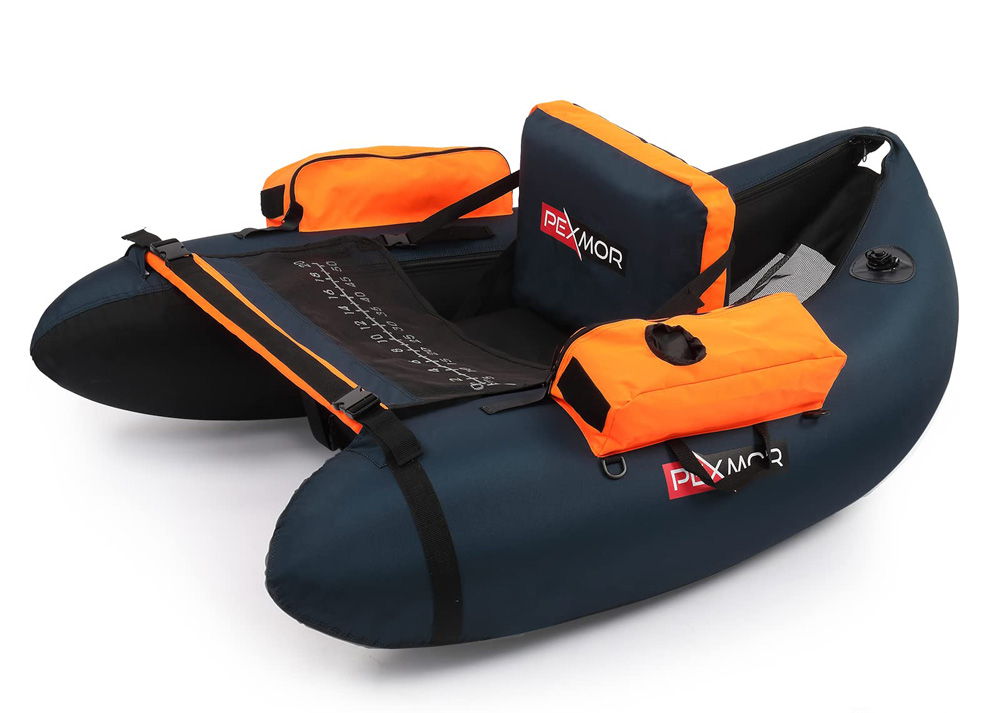
This is a solid pick for casual anglers who want comfort without dropping a ton of cash.
Pros
- High weight limit—carries bigger folks and gear no problem
- Super quick to set up; you’ll be on the water in no time
- Padded seat actually makes longer sessions bearable
Cons
- Pump feels cheap—might want to upgrade
- Some units develop slow leaks (warranty covers it, but still…)
- Seat can be a bit slippery for some body types
We were pleasantly surprised by the build for the price. The material is thick and confidence-inspiring. Setup is a breeze—maybe five minutes once you figure it out. The included pump is just okay, so if you’re picky, grab a small electric one instead. Everything fits into the carry bag without much wrestling.
On the water, the seat’s padding is a win for longer outings. The cargo net up front holds more than you’d expect—tackle, spare rods, snacks. We liked sitting higher up compared to other tubes, which keeps you drier and makes casting easier.
Pockets are handy, but depending on your size, you might slide around on the seat. We noticed some inconsistency in quality between units, so it’s a bit of a gamble. Still, for the price, it’s tough to beat.
SereneLife Inflatable Fishing Float Tube
If you want to reach those tucked-away fishing holes but don’t want to shell out for a pricey boat, this float tube is a solid bet.
Pros
- Elevated seat keeps you mostly dry—even after hours out there
- Built-in rod holders and storage make life easier
- PVC feels tough and shrugs off bumps and scrapes
Cons
- Inflation by hand takes some patience—expect about 10 minutes
- Rod holders could be better placed depending on how you fish
- Weighs over 22 pounds, so not the lightest to carry around
We found this float tube opens up water you just can’t get to from shore. The PVC is thick and doesn’t flex much, even when climbing in. Sitting up high means you only get wet from the knees down—way more comfortable for long days.
Pumping it up takes some effort, but it’s not a deal breaker. Storage pockets are decent, and the built-in fish ruler is a nice touch.
Rod holders work for trolling, but casting takes some adjustment. Still, having your hands free while waiting for a bite is a real plus. Overall, it’s a good value for what you get.
Float Tube For Fishing Buying Guide
Picking out a float fishing boat isn’t rocket science, but there are a few things you’ll want to think about. It really depends on how you fish and where you’re going.
Size and Capacity
Small boats are great for quiet lakes and ponds. If you’re heading into rougher water, a bigger boat is safer (though usually pricier).
Always check the weight capacity. Make sure it’ll handle you, your buddies, and all your gear.
Hull Design
Flat-bottom boats are super stable and good in shallow spots. V-hulls do better if you’re dealing with choppy water.
Pontoon boats? Tons of stability. They’re perfect if you’re new to this or just want a chill day.
Material Options
| Material | Pros | Cons |
|---|---|---|
| Aluminum | Lightweight, durable, doesn’t need much upkeep | Noisy, dents easier than you’d think |
| Fiberglass | Smooth ride, quiet | Heavier, needs more TLC |
| Inflatable | Packs down small, easy to carry | Not as tough, risk of punctures |
Motor Compatibility
Double-check what kind of motor the boat takes. Some only work with electric, others can handle a small gas outboard.
Electric motors are quiet, which is nice for fishing. Gas gives you more power if you’re covering big water.
Storage Features
Built-in storage is always a plus. Rod holders keep things tidy.
Live wells are great for keeping fish fresh, and tackle storage keeps your stuff organized.
Price Range
Set a budget, and don’t forget extras like motors, batteries, and safety gear.
Used boats can save you cash, but check for issues. New boats usually have warranties and sometimes better features.
Frequently Asked Questions
There’s a lot to consider with float fishing boats—features, size, material, you name it. People usually want to know about how tough they are, what’s required for safety, and what kind of upkeep is involved.
What features are important to consider when purchasing a float fishing boat?
We’d say reinforced bottoms and multiple air chambers are must-haves. They help protect against punctures and give you a backup if one chamber goes down.
Rod holders are a game changer for hands-free fishing. Four is a good minimum. Adjustable oar locks are nice if you deal with different water types.
Look for dry storage for your gear. Mesh side pockets are handy for the little stuff—tackle, water bottles, snacks.
D-rings let you attach extra gear or an anchor. Sturdy valves make inflating and deflating a lot less annoying, too.
How do I choose the best size for a float fishing boat?
Honestly, it comes down to how many folks you’re taking with you. If it’s just you, something in the 8-9 foot range is usually plenty. Bringing a buddy? You’ll want at least 10-12 feet so you both have some elbow room.
But here’s the thing—weight capacity actually matters more than just length. Always check that the boat can support you and your gear together. Most manufacturers post that max weight limit somewhere obvious, but I’d double-check before buying.
Think about where you fish most. Tight, winding rivers? Shorter boats are easier to spin around and dodge obstacles. Big, open lakes? Longer boats track straighter and don’t get pushed around by wind as much.
Storage is a real-world issue too. Inflatable boats shrink down small, so if you’re short on garage space, that’s a bonus.
What are the pros and cons of inflatable versus solid float fishing boats?
Inflatables are easier on the wallet and don’t hog space. You can squeeze most of them into a trunk or even a closet, no problem. Weight-wise, they’re much lighter than solid boats, which is a relief when you’re lugging them around.
The catch? You’ll spend 10-15 minutes inflating before you hit the water. Solid boats are ready to go right off the trailer or roof rack, so that’s nice if you’re impatient like me.
When it comes to rough water or rocky spots, solid boats take a beating better. Inflatables can get punctured, but honestly, the good ones are tougher than you’d think. If you treat them right, a quality inflatable can last you 5-10 years.
Solid boats just feel sturdier in wind and waves. They slice through the chop and don’t get tossed around as much, which is comforting when things get bumpy.
Which float fishing boat models are known for their durability and performance?
I’m a fan of the Outcast PAC 1200 for solo trips. The PVC on this thing is thick, and I’ve seen it survive years of hard use. The seat moves around, so you can actually get comfortable for once.
If you’re fishing with a partner, the NRS Freestone Drifter is a solid pick. That aluminum frame is no joke, and it’ll handle Class II rapids without making you sweat. The rowing setup is pretty intuitive too.
For inflatables, the Sea Eagle 375fc stands out. It’s made with heavy-duty PVC, and the rigid floor means you can stand and cast without wobbling all over.
The Aire Tributary Tomcat isn’t cheap, but it outlasts most boats. A lot of guides swear by it because it can take daily abuse and still perform on rough water.
What safety equipment is required on float fishing boats?
You’ll need a Coast Guard approved life jacket for every person on board. Make sure they actually fit and aren’t falling apart—no busted buckles or torn straps.
Most places require a whistle or some kind of sound device. I just clip a plastic whistle to my life jacket; it’s easy and you won’t lose it that way.
On bigger lakes or rivers, you’ll also need visual distress signals. Flares or a simple signal mirror usually do the trick, but double-check your local rules just in case.
If your boat’s over 16 feet, you’ll need a throwable flotation device—like a seat cushion or ring buoy that floats. Handy if someone takes an unexpected swim.
How do maintenance requirements differ between small and large float fishing boats?
Small inflatable boats just want a quick rinse after a day out—mud and sand seem to find every crevice, don’t they? A splash of fresh water usually does the trick. Before tucking it away, check the air pressure; sometimes you’ll need to top it off.
With bigger boats, things get a bit more involved. Scrubbing down the hull is a must, and hardware likes to work itself loose or get a little rusty, so give bolts and fittings a once-over. Moving parts—oar locks, seat adjusters—appreciate a little grease now and then.
Inflatables are fussy about air pressure. Temperature swings really mess with them. Cold mornings? You’ll probably have to add air. Hot afternoons? Sometimes you actually need to let a bit out. It’s a bit of a dance.
Solid boats, on the other hand, should get their hulls checked for cracks or weird spots at least once a year. If you’re out in choppy water a lot, it’s not a bad idea to have a pro look everything over every few years—just for peace of mind.

